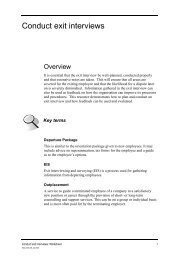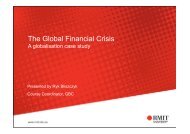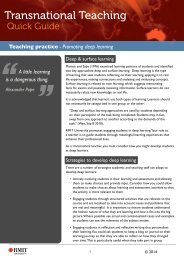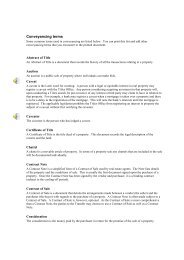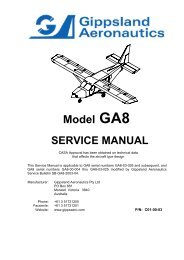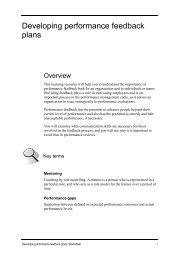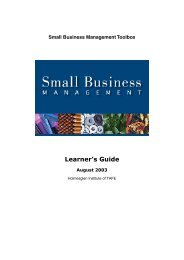Understanding the Course Experience Survey - RMIT University
Understanding the Course Experience Survey - RMIT University
Understanding the Course Experience Survey - RMIT University
- No tags were found...
Create successful ePaper yourself
Turn your PDF publications into a flip-book with our unique Google optimized e-Paper software.
Transnational TeachingQuick GuideAssessment & Feedback - <strong>Understanding</strong> <strong>the</strong> <strong>Course</strong> <strong>Experience</strong> <strong>Survey</strong> (HE)Student feedback & <strong>the</strong> <strong>Course</strong> <strong>Experience</strong> <strong>Survey</strong>We cannotbecome what we wantto be by remainingwhat we are.Max DePree<strong>RMIT</strong> <strong>University</strong> has standardized <strong>the</strong> collection and reporting of course levelstudent feedback in accordance with <strong>the</strong> university’s Student Feedback Policy[http://www.rmit.edu.au/policies/studentfeedback ]. This policy toge<strong>the</strong>r witho<strong>the</strong>r factors requires <strong>the</strong> <strong>University</strong> to systematically and transparentlyobtain student feedback at individual course level. The <strong>Course</strong> <strong>Experience</strong><strong>Survey</strong> (CES) is used for this purpose.[http://www.rmit.edu.au/ssc/courseexperiencesurvey]<strong>Survey</strong> forms have two sections. The survey questions in Section One of <strong>the</strong>forms address <strong>the</strong> following <strong>the</strong>mes:• Feedback• Quality of <strong>the</strong> Teaching and Learning environment• Learning Objectives• Clear Goals• Assessment – workload• Commitment of staff – pastoral care• <strong>Course</strong> interest• Overall Student Satisfaction• Preparedness for <strong>the</strong> workplaceAdditional question items can be added by individual staff to ga<strong>the</strong>rinformation of interest from a specific course or class.Section Two of <strong>the</strong> form has spaces for student comments, and tick boxes forbasic student demographic information. Student comments in Section Twocomplement <strong>the</strong> quantitative responses elicited from Section One to build apicture of <strong>the</strong> student’s course experience for a specific teaching period.The <strong>Survey</strong> Services Centre (SSC) has a comprehensive online FAQ[http://www.rmit.edu.au/ssc/ces/faq] about <strong>the</strong> CES. This webpage also hascontact details for key staff who can answer questions about <strong>the</strong> CES.Administering <strong>the</strong> <strong>Course</strong> <strong>Experience</strong> QuestionnaireThe CES is administered online each time a course is offered. The survey isadministered between weeks 9 to 12.Each semester <strong>the</strong> SSC contacts schools with a list of courses to be surveyed.Schools validate <strong>the</strong> information and <strong>the</strong> SSC prepares <strong>the</strong> survey.1 © 2014
<strong>Understanding</strong> <strong>the</strong> results – (HE)Schools receive a document summarising <strong>the</strong> results for each class set ofsurvey forms processed by <strong>the</strong> <strong>RMIT</strong> <strong>Survey</strong> Services Centre. Informationat <strong>the</strong> top of page one includes staff name and course code and title. Usefuldemographic details on <strong>the</strong> cohort surveyed include age distribution,distribution of number of hours per week studied in <strong>the</strong> course, and <strong>the</strong>numbers of fulltime, part time and local or international students. Thesedetails provide background information against which to interpret <strong>the</strong> laterresults. From S1 2013, reliability bands will be published on all teacherreports.The second part of page one gives a summary of responses to <strong>the</strong> surveyitems. The survey comprises 13 items with responses coded from 1 =‘strongly disagree’ to 5 = ‘strongly agree’. All items are worded positively, sothat higher scores indicate greater student satisfaction.The summary graph shows <strong>the</strong> percentage of respondents who answeredin <strong>the</strong> top two categories (‘agree’ or ‘strongly agree’) for each item. Notethat <strong>the</strong> scale displayed for <strong>the</strong>se graphs varies according to <strong>the</strong> highestpercentage achieved. Anyone scanning a number of <strong>the</strong>se summarydocuments should be careful to take note of <strong>the</strong> scale used. As a generalrule, any item achieving less than 65% agreement should give cause forreflection.The final piece of information on <strong>the</strong> summary page is <strong>the</strong> Good TeachingScale score, comprising items 8 to 13. This gives an overall indication ofstudent satisfaction, and is <strong>the</strong> same scale used in program surveys includingStudent <strong>Experience</strong> <strong>Survey</strong>s.The remaining pages of <strong>the</strong> document give <strong>the</strong> results for individual items,including <strong>the</strong> additional items that may have been included by <strong>the</strong> teacher.These must obviously be examined with <strong>the</strong> additional information of <strong>the</strong>wording of <strong>the</strong> items as provided separately to <strong>the</strong> students. Each individualitem has a bar graph showing <strong>the</strong> response distribution toge<strong>the</strong>r with a meanscore based on <strong>the</strong> numerical values given to <strong>the</strong> responses. A mean of 4 orhigher indicates a positive student response (an ‘average’ in <strong>the</strong> ‘agree’ to‘strongly agree’ range).1 2(Strongly disagree)Staff reflecting on <strong>the</strong>ir feedback results should first consider <strong>the</strong> overallGood Teaching Scale score, and <strong>the</strong>n look at responses to individual items.Consistently low percentage agree scores or mean response scores in itemsgrouped under a particular <strong>the</strong>me can indicate a need to focus on strategiesfor improvement in that area.Interpreting & informing practiceThe items in <strong>the</strong> <strong>Course</strong> <strong>Experience</strong> <strong>Survey</strong> can be classified into <strong>the</strong>mes.These are listed below, toge<strong>the</strong>r with some suggestions for staff to considerwhen formulating responses.2 © © 2014
Teaching style – Organisation1. The learning objectives in this course are clear to meDo you:• Align learning objectives, learning outcomes, learning activities andassessment? Do you evaluate this alignment? For example, do you knowif <strong>the</strong>re are gaps in it? Do you assess what you teach? Does your contentcontribute to <strong>the</strong> stated objectives of <strong>the</strong> course?• Explain and discuss with students how <strong>the</strong> learning activities andassessments help <strong>the</strong>m to achieve <strong>the</strong> learning objectives and outcomes?Teaching style - Delivery8. The teaching staff are extremely good at explaining things10. The teaching staff in this course motivate me to do my best work11. The teaching staff work hard to make this course interestingDo you:• Chunk your lecture into coherent sections? Introduce each section withan overview and explanation of where it fits with what has gone before?Summarise key points of each section at <strong>the</strong> end?• Engage <strong>the</strong> students by seeking informal feedback at intermediate pointsin <strong>the</strong> class?• Think about how <strong>the</strong> students engage with your material – do <strong>the</strong>y just sitand listen?• Provide opportunities through <strong>the</strong> lecture for students to make activeresponses?• Provide work related examples to your students so that <strong>the</strong>y may make<strong>the</strong> link between <strong>the</strong>ory and practice.• Organise guest speakers to give a lecture in your course which may addvalue to <strong>the</strong> content? How often do you invite a guest speaker?• Use relevant examples of concepts (from current events, popular culture,etc) so students can connect to <strong>the</strong> content?• Value-add to what is in <strong>the</strong> textbook? How do you do this?• Allow for active student participation in tutorials using problems, casestudies, questions, exercises?• Provide plenty of opportunities in tutorials for students to raise anddiscuss questions with you?• Use student centred teaching styles? Do you know on a weekly basiswhere your students are in relation to <strong>the</strong> learning outcomes of <strong>the</strong>course? Do you use micro evaluation techniques, such as asking yourstudents on a regular basis: “What is <strong>the</strong> key thing you have learnt today?”,“What was <strong>the</strong> key thing you learnt in <strong>the</strong> last session?”• Get feedback from different student groups, for example, internationalstudents, students from different programs?3 © © 2014
Assessment & feedback9. The teaching staff normally give me helpful feedback on how I am going in thiscourse3. Assessment tasks in this course require me to demonstrate what I am learning4. The amount of work required in this course is about right12. The staff make a real effort to understand <strong>the</strong> difficulties I may be having with mywork13. The staff put a lot of time into commenting on my work.Do you:• Look at <strong>the</strong> teaching and assessment schedule. Are <strong>the</strong> assessment tasksevenly placed through <strong>the</strong> semester? Is <strong>the</strong>re sufficient time betweenintroducing a concept and assessing it? Is <strong>the</strong> student workload spreadfairly through <strong>the</strong> semester (within and between courses/programs inyour School?)• Provide opportunities for regular formal and informal feedbackthroughout <strong>the</strong> semester?• Align <strong>the</strong> learning objectives, learning outcomes and assessment?• Use strategies for providing bulk feedback. For example, using technology(eg Blackboard) to give comments on assessment strengths, deficiencies,common problems or issues?• Provide a mark sheet to return with assignments which lists <strong>the</strong>assessment criteria, so students can see <strong>the</strong>ir performance against eachcriterion and how <strong>the</strong> overall mark was awarded? Do you providefeedback on each main criterion?• Provide model answers, peer review and/or peer assessmentopportunities? Do you know how to provide <strong>the</strong>se opportunities in waysthat benefit you and <strong>the</strong> learner?• Explain written feedback with students upon request?• Use specific strategies with students from non English speakingbackground or students with comprehension and learning difficulties?• Use teaching and learning assessment/plagiarism support packages such asTurnitin?Capabilities & workplace readiness2. This course contributes to my confidence in tackling unfamiliar problems5. I can see how this course will help me in <strong>the</strong> workplaceDo you:• Use real life examples from <strong>the</strong> workplace in your lectures?• Encourage students in <strong>the</strong> final year of <strong>the</strong>ir program to reflect on <strong>the</strong>irco-op experiences and share <strong>the</strong>m with fellow students as <strong>the</strong>y relate to<strong>the</strong> particular subject matter?• Teach students to be reflective practitioners? How do you assess this?• Relate <strong>the</strong> content of your course to o<strong>the</strong>r courses in <strong>the</strong> program /common core as appropriate?4 © © 2014
Useful resourcesSupport is available from your Deputy Head of School (Learning & Teaching) orequivalent. Your College Academic Development Group or learning & teachingspecialist can also provide advice, support and professional development.The CES results may highlight areas for streng<strong>the</strong>ning your teaching practice.There are a number of resources available to assist you with interpreting yourCES results, including:• The CES Analysis Project:http://www.rmit.edu.au/teaching/cesanalysis• <strong>Survey</strong> Services Centre (SSC):http://www.rmit.edu.au/ssc5 © © 2014





